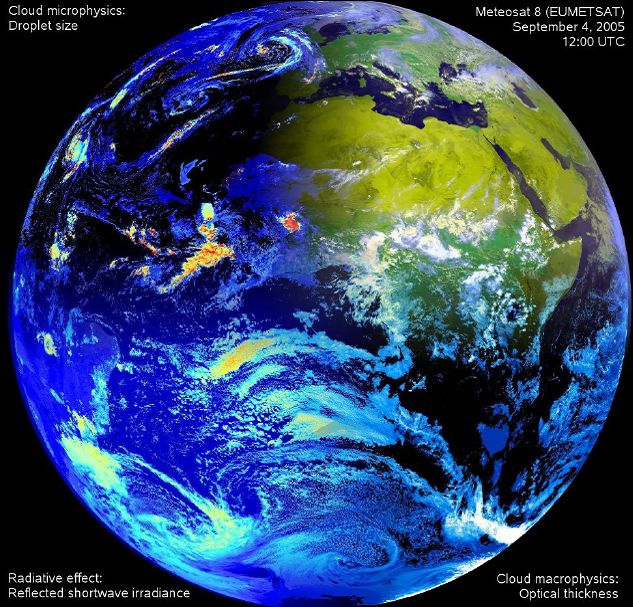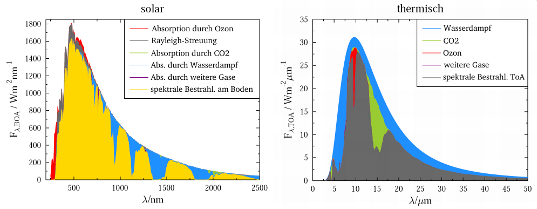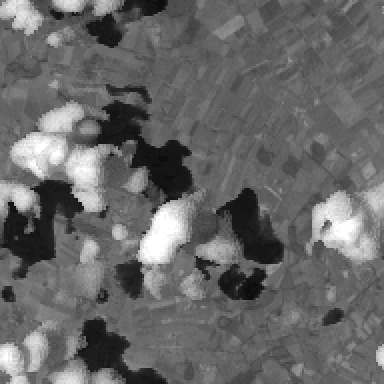 |
My career started with the simulation of radiative transfer
in the Earth's atmosphere. Sience then I simulated
radiative forcing of clouds and aerosols, used radiative
transfer in remote sensing. In my current job I use
SEVIRI observation to predict the development of
thunderstorms.
Content of this page:
During my PhD I implemented a couple of improvements in the radiative transfer model
libRadtran of B. Mayer and A. Kylling
(Mayer, 2005).
 I also used the three dimensional radiative transfer model MYSTIC:
I also used the three dimensional radiative transfer model MYSTIC:

|
 |
|
 |
 |
This figures shows, how the earth looks like from the
Meteosat Second Generation / SEVIRI on January 29, 2007 at 10:30 UTC.

MSG false color composite
Copyright: Eumetsat 2007
The measured radiance is influenced by the albedo of the Earth's surface, the clouds,
and by the trace gases. Therefor it is possible to derive quantitative informations
of them. E.g. it is possible to derive cloud top temperatures, cloud optical depth,
cloud water content, cloud phase (ice or water) and the
effective radius of cloud droplets or cloud ice crystals.
The next diagram illustrates the capabilities of remote sensing from MSG.
This figure shows a false color composite (upper right), cloud optical thickness (lower right),
reflected solar irradiance (lower left), and effective cloud droplet size (upper left).

Remote sensing from Meteosat Second Generation
by Mayer, B. and Bugliaro, L.
Radiative forcing measures the influence that climate-altering factors have on the energy balance of the Earth. Examples of factors that can alter the Earth's energy balance include atmospheric concentrations of greenhouse gases, aerosols from volcanoes and air pollution, and the amount of solar radiation delivered to the Earth by the Sun.

Forster, P., et al. 2007. Changes in atmospheric constituents and in radiative forcing.
In Climate Change 2007: The Physical Science Basis
To investigate radiative forcing the radiative transfer in the atmosphere has to be simulated in detail.
Radiation is the form of energy, that is exchanged with space. Solar irradiance
warms the atmosphere and the earth's surface. It drives the atmospheric circulation
and is therefor important for weather and climate.
Trenberth et al, 2009
discuss, how solar and thermal radiation is absorbed, scattered, reflected,
and emitted in the atmosphere and at the surface of the earth, see this
figure.
The following diagrams show how the solar and thermal radiation is attenuated by scattering and absorption
on its way through the atmosphere.

Source: Hamann, 2010
The detailed knowledge of the radiation fields are used in various applications:
- Climate change and weather prediction
- Solar energy and effects of UV on man and nature
- Remote sensing of the atmosphere and its constituents
- Remote sensing of the earth's surface
The propagation of directional dependent radiance L in a media is described by the radiative
transfer equation (Chandrasekhar, 1960):
 where βext is the extinction coefficient.
The left hand side and the first term on the right hand side describes
the attenuation by scattering and absorption.
The second term characterizes the scattering of radiation by particles like
cloud droplets or aerosols.
where βext is the extinction coefficient.
The left hand side and the first term on the right hand side describes
the attenuation by scattering and absorption.
The second term characterizes the scattering of radiation by particles like
cloud droplets or aerosols.
 ,
where the phase function P describes the probability distribution,
that radiance from the direction (Θ',Φ') is scattered in the
direction (Θ,Φ). The single scattering albedo ω0
is the probability, that a photon is scattered (and not absorbed).
The last term on the right hand side represent the thermal emission. ,
where the phase function P describes the probability distribution,
that radiance from the direction (Θ',Φ') is scattered in the
direction (Θ,Φ). The single scattering albedo ω0
is the probability, that a photon is scattered (and not absorbed).
The last term on the right hand side represent the thermal emission.
 where B(T) is the temperature dependent Planck emission of black bodies.
B. Mayer and A. Kylling develop an advanced radiative transfer tool called
libRadtran,
that is freely available under the GNU General Public License.
It can solve the radiative transfer equations for horizontal homogeneous
atmospheric layers.
Another program, that is also developed by the group of B. Mayer, is
MYSTIC,
the Monte Carlo code for the physically correct tracing of photons in cloudy atmospheres
(Emde, 2007; Mayer, 2009).
It can handle three dimensional clouds, inhomogeneous surface albedo and topography,
and the spherical effects of the earth's atmosphere. The next figure shows a MYSTIC simulation
of the nadir radiance at top of atmosphere for a three dimensional cloud field above
inhomogeneous albedo.
where B(T) is the temperature dependent Planck emission of black bodies.
B. Mayer and A. Kylling develop an advanced radiative transfer tool called
libRadtran,
that is freely available under the GNU General Public License.
It can solve the radiative transfer equations for horizontal homogeneous
atmospheric layers.
Another program, that is also developed by the group of B. Mayer, is
MYSTIC,
the Monte Carlo code for the physically correct tracing of photons in cloudy atmospheres
(Emde, 2007; Mayer, 2009).
It can handle three dimensional clouds, inhomogeneous surface albedo and topography,
and the spherical effects of the earth's atmosphere. The next figure shows a MYSTIC simulation
of the nadir radiance at top of atmosphere for a three dimensional cloud field above
inhomogeneous albedo.

MYSTIC simulation of the nadir radiance
Source: http://www.bmayer.de
Chandrasekhar, S.
Radiative transfer
text book, ISBN: 0486605906, Dover, 1960
Emde, C. and Mayer, B.
Simulation of solar radiation during a total eclipse: A challenge for radiative transfer
Atmospheric Chemistry and Physics, vol. 7(9), page: 2259-2270, 2007
Hamann, U.
Die Erwärmungsrate der tropischen Tropopausenregion
Digitale Hochschulschriften der Ludwig-Maximilians-Universität München, 2010
Mayer, B. and Kylling, A.
Technical note: The libRadtran software package for radiative transfer calculations - description and examples of use
Atmospheric Chemistry and Physics, vol. 5, page: 1855-1877, 2005
Mayer, B.
Radiative transfer in the cloudy atmosphere
The European Physical Journal Conferences, DOI: 10.1140/epjconf/e2009-00912-1, page: 75-99, 2009
Trenberth, K. E., Fasullo, J. T., Kiehl, J.
Earth's global energy budget
Bulletin of the American Meteorological Society, vol. 90(3), page: 311-323, 2009
|
|
|